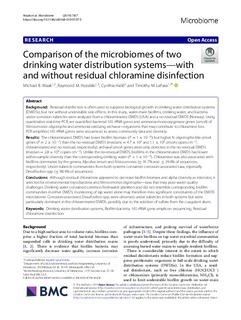| dc.contributor.author | Waak, Michael B | |
| dc.contributor.author | Hozalski, Raymond M | |
| dc.contributor.author | Halle, Cynthia | |
| dc.contributor.author | LaPara, Timothy M | |
| dc.date.accessioned | 2019-09-27T07:34:33Z | |
| dc.date.available | 2019-09-27T07:34:33Z | |
| dc.date.created | 2019-07-16T12:34:28Z | |
| dc.date.issued | 2019 | |
| dc.identifier.citation | Microbiome. 2019, 7 (87), 1-14. | nb_NO |
| dc.identifier.issn | 2049-2618 | |
| dc.identifier.uri | http://hdl.handle.net/11250/2619065 | |
| dc.description.abstract | Background
Residual disinfection is often used to suppress biological growth in drinking water distribution systems (DWDSs), but not without undesirable side effects. In this study, water-main biofilms, drinking water, and bacteria under corrosion tubercles were analyzed from a chloraminated DWDS (USA) and a no-residual DWDS (Norway). Using quantitative real-time PCR, we quantified bacterial 16S rRNA genes and ammonia monooxygenase genes (amoA) of Nitrosomonas oligotropha and ammonia-oxidizing archaea—organisms that may contribute to chloramine loss. PCR-amplified 16S rRNA genes were sequenced to assess community taxa and diversity.
Results
The chloraminated DWDS had lower biofilm biomass (P=1×10−6) but higher N. oligotropha-like amoA genes (P=2×10−7) than the no-residual DWDS (medians =4.7×104 and 1.1×103amoA copies cm−2, chloraminated and no residual, respectively); archaeal amoA genes were only detected in the no-residual DWDS (median =2.8×104 copies cm−2). Unlike the no-residual DWDS, biofilms in the chloraminated DWDS had lower within-sample diversity than the corresponding drinking water (P<1×10−4). Chloramine was also associated with biofilms dominated by the genera, Mycobacterium and Nitrosomonas (≤91.7% and ≤39.6% of sequences, respectively). Under-tubercle communities from both systems contained corrosion-associated taxa, especially Desulfovibrio spp. (≤98.4% of sequences).
Conclusions
Although residual chloramine appeared to decrease biofilm biomass and alpha diversity as intended, it selected for environmental mycobacteria and Nitrosomonas oligotropha—taxa that may pose water quality challenges. Drinking water contained common freshwater plankton and did not resemble corresponding biofilm communities in either DWDS; monitoring of tap water alone may therefore miss significant constituents of the DWDS microbiome. Corrosion-associated Desulfovibrio spp. were observed under tubercles in both systems but were particularly dominant in the chloraminated DWDS, possibly due to the addition of sulfate from the coagulant alum. | nb_NO |
| dc.language.iso | eng | nb_NO |
| dc.publisher | BMC | nb_NO |
| dc.rights | Navngivelse 4.0 Internasjonal | * |
| dc.rights.uri | http://creativecommons.org/licenses/by/4.0/deed.no | * |
| dc.title | Comparison of the microbiomes of two drinking water distribution systems—with and without residual chloramine disinfection | nb_NO |
| dc.type | Journal article | nb_NO |
| dc.type | Peer reviewed | nb_NO |
| dc.description.version | publishedVersion | nb_NO |
| dc.source.pagenumber | 1-14 | nb_NO |
| dc.source.volume | 7 | nb_NO |
| dc.source.journal | Microbiome | nb_NO |
| dc.source.issue | 87 | nb_NO |
| dc.identifier.doi | 10.1186/s40168-019-0707-5 | |
| dc.identifier.cristin | 1711648 | |
| dc.description.localcode | © The Author(s). 2019 Open Access This article is distributed under the terms of the Creative Commons Attribution 4.0 International License ( http://creativecommons.org/licenses/by/4.0/ ), which permits unrestricted use, distribution, and reproduction in any medium, provided you give appropriate credit to the original author(s) and the source, provide a link to the Creative Commons license, and indicate if changes were made. The Creative Commons Public Domain Dedication waiver ( http://creativecommons.org/publicdomain/zero/1.0/ ) applies to the data made available in this article, unless otherwise stated. | nb_NO |
| cristin.unitcode | 194,64,91,0 | |
| cristin.unitname | Institutt for bygg- og miljøteknikk | |
| cristin.ispublished | true | |
| cristin.fulltext | original | |
| cristin.qualitycode | 1 | |

